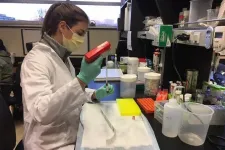(Press-News.org) A test that monitors blood levels of DNA fragments released by dying tumor cells may serve as an accurate early indicator of treatment success in people in late stages of one of the most aggressive forms of skin cancer, a new study finds.
Led by NYU Grossman School of Medicine and Perlmutter Cancer Center researchers, the investigation looked at adults with undetectable levels of freely circulating tumor DNA (ctDNA) four weeks into drug treatment for metastatic melanoma tumors that cannot be removed surgically (unresectable). The study showed that these patients, all of whom had common genetic changes (BRAFV600 mutations) linked to cancer, were living nearly twice as long without cancer growth as those who continued to have detectable levels.
Normally, the study authors say, physicians would have to wait three months before an X-ray, CT scan, or other measures could reveal whether a tumor is growing or shrinking in response to treatment.
"Our findings suggest that levels of ctDNA may serve as a fast and reliable tool to gauge whether an anticancer medication is working," says study senior author David Polsky, MD, PhD. "The blood test results could help support continuing the current treatment strategy or else encourage patients and physicians to consider other options," adds Polsky, the Alfred W. Kopf, M.D. Professor of Dermatologic Oncology at NYU Langone Health and its Perlmutter Cancer Center.
Polsky notes that swift treatment modification could potentially be helpful in a disease as aggressive as melanoma, which kills nearly 7,000 Americans a year and is notoriously difficult to treat once it spreads to other body parts. Early feedback from a blood test might save lives, he says.
Researchers have long searched for better ways to monitor certain cancers using blood tests, or so-called biomarkers, which can be performed more easily, more often, and less expensively than imaging scans or surgical procedures and provide a clearer picture of tumor behavior over time. With melanoma, one frequently used option, a test for the presence in blood of an enzyme called lactate dehydrogenase (LDH), has had only limited success as such a tool, because non-cancer ailments such as liver injury and bone damage can also cause levels to spike. Although more specific biomarkers have been identified in cancers of the prostate, breast, and colon, the study investigators say a reliable signpost for melanoma has until now remained elusive.
According to Polsky, also a professor in the Department of Pathology at NYU Langone, early research by the same team had pointed to ctDNA as a promising candidate. This method works by targeting the most common mutations in the DNA code found in melanoma cells. This mutated DNA spills into surrounding blood as the cancer cells break down. In previous small studies, the blood test was shown to outperform LDH in predicting melanoma recurrence, as well as tracking progression of other forms of cancer.
The new investigation, publishing Feb. 11 in the journal The Lancet Oncology, was conducted over two years and is the largest analysis to date of the potential utility of this blood test for skin cancer, says Polsky.
For the study, the research team analyzed blood samples from two pivotal clinical trials involving 383 American, European, and Australian men and women. All were receiving targeted treatment with drugs dabrafenib and trametinib for unresectable metastatic melanoma tumors that had mutations in the BRAF gene, which is found in about half of all patients with the disease, investigators say. The investigators measured levels of ctDNA from patients whose tumors had this mutation before treatment and one month into therapy. As part of the clinical trial, patients received periodic checkups using CT scans until treatment ended.
Among the study's other findings were that patients with 64 or fewer copies of ctDNA per milliliter of blood before treatment were likely to respond well to therapy, surviving nearly three years on average. By contrast, levels above that threshold were linked to a significantly poorer chance of survival, with patients living just over a year.
The investigators say the blood test is highly reliable, as they were able to detect ctDNA in 93 percent of patients. These blood test results were also reproduced in a second group of patients in the same stage of the disease who were enrolled in another clinical trial.
"Although this gene-based test focuses on tumors with BRAFV600 mutations, we believe it will be similarly useful for melanomas that have other mutations, such as defects in the NRAS and TERT genes, which are also commonly mutated in this disease," study lead author Mahrukh Syeda, MS. "Ultimately, we'd like to see this test used routinely in the clinic to help guide treatment decisions," adds Syeda, a research scientist in the Department of Dermatology at NYU Langone Health.
She cautions that the blood test is not yet FDA-approved, but notes that the evidence of its accuracy and value supports future applications for approval to make it available for clinical use.
Syeda says the team next plans to evaluate the ctDNA approach in patients in earlier stages of melanoma.
INFORMATION:
Funding support for the study was provided by Novartis Pharmaceuticals Corporation in East Hanover, N.J.
Besides Polsky and Syeda, other NYU Langone researchers include Jennifer Wiggins, PhD; and Broderick C Corless, BS. Other co-investigators are Georgina Long, MD, at the University of Sydney; Keith Flaherty, MD, at Harvard Medical School in Boston; Dirk Schadendorf, MD, at the German Cancer Consortium in Heidelberg, Germany; Paul Nathan, MD, at East and North NHS Trust in Northwood, England; Caroline Robert, MD, at Paris-Sud University in Villejuif, France; Antoni Ribas, MD, at the University of California in Los Angeles; Michael Davies, MD, at the University of Texas in Houston; and Jean Jacques Grob, MD, at Aix-Marseille University in France. Additional authors were Eduard Gasal, MD, and Mahtab Marker, PhD at Novartis; Matthew Squires, PhD, at Novartis Institute for BioMedical Research in Cambridge, Mass.; and James Garrett, PhD, and Jan Brase, PhD, at Novartis Pharma AG in Basel, Switzerland.
Media Inquiries
Shira Polan
212-404-4279
shira.polan@nyulangone.org
Peer-reviewed / Review, Survey and Opinion piece
To ensure an effective global immunisation strategy against COVID-19, vaccines need to be produced at scale, priced affordably, and allocated globally so that they are available where needed, and successfully rolled out.
Review of evidence includes a comparison of 26 leading vaccines on their potential contribution to achieving global vaccine immunity, and a new survey of COVID-19 vaccine confidence in 32 countries.
Having new COVID-19 vaccines will mean little if people around the world are unable to get vaccinated in a timely manner. ...
A new study from Washington University School of Medicine in St. Louis demonstrates that a liquid biopsy examining blood or urine can help gauge the effectiveness of therapy for colorectal cancer that has just begun to spread beyond the original tumor. Such a biopsy can detect lingering disease and could serve as a guide for deciding whether a patient should undergo further treatments due to some tumor cells evading an initial attempt to eradicate the cancer.
The study appears online Feb. 12 in the Journal of Clinical Oncology Precision Oncology, a journal of the American Society of Clinical Oncology.
While a few liquid biopsies have been approved ...
FOR IMMEDIATE RELEASE
Scientists have yet to answer the age-old question of whether or how sound shapes the minds of fetuses in the womb, and expectant mothers often wonder about the benefits of such activities as playing music during pregnancy. Now, in experiments in newborn mice, scientists at Johns Hopkins report that sounds appear to change "wiring" patterns in areas of the brain that process sound earlier than scientists assumed and even before the ear canal opens.
The current experiments involve newborn mice, which have ear canals that open 11 days after birth. In human fetuses, the ear canal opens prenatally, at about 20 weeks gestation.
The findings, published online Feb. 12 in END ...
A more aggressive approach to treating acne that marries the disciplines of psychology and dermatology is needed, according to two UC Riverside psychology researchers.
They also assert that women and people with darker skin disproportionately suffer from acne's psychological impacts.
"Acne is pervasive, physically harmless, and painless, so we all-too-often underestimate its impacts as the quintessential nuisance of adolescence and puberty," said UCR psychology professor Misaki Natsuaki, who authored the paper along with Tuppett Yates, also a UCR psychology professor.
The insinuation, including by developmental scientists, can be that hurtful monikers such as "pizza face" and "crater face" are best shrugged off.
But psychological ...
Using observations from NASA's Transiting Exoplanet Survey Satellite (TESS), an international team of astronomers has discovered a trio of hot worlds larger than Earth orbiting a much younger version of our Sun called TOI 451. The system resides in the recently discovered Pisces-Eridanus stream, a collection of stars less than 3% the age of our solar system that stretches across one-third of the sky.
The planets were discovered in TESS images taken between October and December 2018. Follow-up studies of TOI 451 and its planets included observations made in 2019 and 2020 using NASA's Spitzer Space Telescope, ...
Masks help protect the people wearing them from getting or spreading SARS-CoV-2, the virus that causes COVID-19, but now researchers from the National Institutes of Health have added evidence for yet another potential benefit for wearers: The humidity created inside the mask may help combat respiratory diseases such as COVID-19.
The study, led by researchers in the NIH's National Institute of Diabetes and Digestive and Kidney Diseases (NIDDK), found that face masks substantially increase the humidity in the air that the mask-wearer breathes in. This higher level of humidity in inhaled air, the researchers suggest, could help explain why wearing masks has been linked to lower disease severity in people infected with SARS-CoV-2, because hydration of the respiratory ...
A new study published in the journal Science Advances shows that Bantu-speaking communities in the Congo rainforest underwent a major population collapse from 1600 to 1400 years ago, probably due to a prolonged disease epidemic, and that significant resettlement did not restart until around 1000 years ago. These findings revise the population history of no less than seven present-day African countries (Cameroon, Central African Republic, Democratic Republic of the Congo, Republic of the Congo, Gabon, Equatorial Guinea, and Angola) and challenges the commonly held belief that the settlement of Central Africa by Bantu-speaking communities was a continuous process from about 4000 years ago until the start of the transatlantic ...
In research that may eventually help crops survive drought, scientists at Princeton University have uncovered a key reason that mixing material called hydrogels with soil has sometimes proven disappointing for farmers.
Hydrogel beads, tiny plastic blobs that can absorb a thousand times their weight in water, seem ideally suited to serve as tiny underground reservoirs of water. In theory, as the soil dries, hydrogels release water to hydrate plants' roots, thus alleviating droughts, conserving water, and boosting crop yields.
Yet mixing hydrogels into farmers' fields has had spotty results. Scientists have struggled to explain these uneven performances in large part because soil--being opaque --has thwarted attempts at observing, analyzing, and ultimately improving hydrogel ...
COVID-19 vaccine prioritization should prioritize those with advanced cardiovascular (CVD) disease over well-managed CVD disease, according to an American College of Cardiology (ACC) health policy statement published in the Journal of the American College of Cardiology (JACC). All CVD patients face a higher risk of COVID-19 complications and should receive the vaccine quickly, but recommendations in this paper serve to guide clinicians in prioritizing their most vulnerable patients within the larger CVD group, while considering disparities in COVID-19 outcomes among different racial/ethnic groups and socioeconomic ...
A new type of drug that helps target chemotherapy directly to cancer cells has been found to significantly increase survival of patients with the most common form of bladder cancer, according to results from a phase III clinical trial led in the UK by Queen Mary University of London and Barts Health NHS Trust.
The results are published in the New England Journal of Medicine and were presented at the 2021 American Society of Clinical Oncology's Genitourinary Cancers Symposium.
Urothelial cancer is the most common type of bladder cancer (90 percent of cases) and can also be found in the renal pelvis (where urine collects inside the kidney), ureter (tube that connects the kidneys ...


